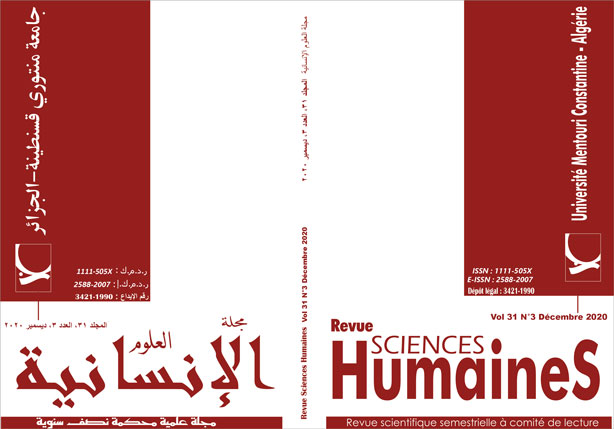Evaluation of Learner Autonomy in the Algerian Third Year Secondary School Textbook ‘New Prospects’
Keywords:
evaluation, autonomy, the Competency Based Approach, secondary education, New ProspectsAbstract
This paper evaluates the Algerian third year secondary school textbook ‘New Prospects’ to discover to what extent its content promotes learner autonomy. New Prospects was designed in compliance with the principles of the Competency Based Approach that aim at producing learners who are competent not only inside the classroom but also in their everyday lives outside of the school by promoting responsibility and autonomy in them. The hypothesis on which the paper is based is that if New Prospects complies to the principles of learner autonomy as stipulated in the CBA it will manage to produce autonomous learners. The methodology adopted in this paper consists of an evaluation checklist elaborated on the basis of the principles constituting autonomous learning identified in the literature review herein. The results obtained indicate that ‘New Prospects’ largely complies to these principles.
Downloads
References
. Arab, S.A. , B. Riche, M. Bensemmane (2007), New Prospects, Secondary Education Year Three, The National Authority For School publications.
. Barfield, A., Ashwell, T., Carroll, M., Collins, K., Cowie, N., Critchley, M., Head, E.,Nix, M., Obermeier, A. & Robertson, M.C. (2001). Exploring and defining teacher autonomy: A collaborative discussion. In A. S. Mackenzie & E.
. Benson, P.(1997).The philosophy and politics of learner autonomy, In P. Benson and P. Voller (eds), Autonomy and Independence in Language Learning. London: Longman, 1997.
. Benson, P. (2000). Autonomy as a learners’ and teachers’ right. In B. Sinclair, I. McGrath and T. Lamb (eds), Learner Autonomy, Teacher Autonomy: Future Directions. Harlow: Longman.
. Chan, V (2003). Autonomous Language Learning: the teacher’s perspectives. Teaching in Higher Education, 8(1). 33-54.
. Chelli, S (2010) The Competency Based Approach in Algeria: a necessity in the Era of Globalisation.
Retrieved on October 23rd 2019 from: fll.univ-biskra_dz/images pdf…pdf_revue…/chelli%20saliha%20.pdf…
. Dam, L. (1994). How do we recognise an autonomous classroom? Die Neueren Sprachen, 93/5, 503-527.
. Fenner, A.B. & Newby, D. (Eds.). (2000). Approaches to Materials Design in European Textbooks: Implementing Principles of Authenticity, Learner Autonomy and Cultural Awareness. Graz/Strasbourg: European Centre for Modern Languages/Council of Europe Press
. Foroutan, M., N. Nooreen, S. H. Gani, and R. Baki. (2013). The Relationship Between Language Learning Autonomy Extent and Learning Styles in Malaysian Context. World Applied Sciences Journal 24, no. 3 (395-402.
. Graham, S. & Harris, K.R. (2000).The role of self-regulation and transcription skills in writing and writing development. Educational Psychology, 35(2), 3-12.
. Holec, H. (1981). Autonomy in Foreign Language Learning. Oxford. Pergamon.
. Ivanovska, B., (2015), Procedia - Social and Behavioral Sciences. 180 352 – 356. Available online at www.sciencedirect.com
. Lap, T. Q. (2005). Stimulating learner autonomy in English language education. A curriculum innovation study in a Vietnamese context. Doctoral thesis. University of Amsterdam.
. Little, David (1991) Learner Autonomy 1 –Definitions, Issues and Problems. Dublin. Authentic Language Learning Resources Ltd, Trinity College
. Littlejohn, A. (1985) Learner choice in language study. ELT Journal, 39(4). 253-261.
. McCafferty (Eds), Developing Autonomy, Proceedings of the College and University Educators’ 2001 Conference, Shizuoka, Japan, pp. 217-22. Tokyo: The Japan Association for Language Teaching. Available at:http:/www.encounters.jp/mike/professional/publications/tchauto.html
. Naiman N., Frohlich, M., Stern,H.H., & Todesco, A. (1978). The Good Language Learner, Toronto, Ontario Institute for Studies in Education.
. Nunan, D. (1988). Syllabus Design. Oxford: Oxford University Press
. Nunan, D. (1997). Designing and Adapting Materials to Encourage Learner Autonomy. In P. Benson, & P. Voller (Eds.). Autonomy and Independence in Language Learning (pp. 192-203). London: Longman.
. Nunan, D. (2000). Nine Steps to Learner Autonomy. Retrieved September 27, 2019, from http://www.andrasprak.su.se/polopoly_fs/1.84007.1333707257!/menu/standard/file/2003_11_Nunan_eng.pdf
. Oxford, R., L. (1991) Language Learning Strategies, What Every Teacher Should Know. New York: Newbury House.
. Richards, J. C., R. Schmidt. (2003) Longman Dictionary of Applied Linguistics and Language Teaching. Longman Publishing Group
. Riche , B., Arab, S.A., H. Ameziane, H. Hami, K. Louadj (20 ??) At The Crossroads, Secondary Education: Year One/ English. The National Authority For School publications.
. Thanasoulas, D. (2000). What is learner autonomy and how can it be fostered. The Internet TESL Journal 6, no. 11 37-48.
. Waite, S. (1994). Low-resourced self-access with EAP in the developing world: the
great enabler. ELT Journal 48/3, pp. 233–42.
. Weddel, K. S. (2006). Definitions components characteristics integrating competencies and content standards: Mapping competencies resources. Retrieved September, 20th 2019 from
http://www.cde.state.co.us/cdeadult/download/pdf/CompetencyBasedEducation.pdf
. Wenden, Anita, (1987) Learner Strategies in Language Learning. Prentice Hall International English Language Teaching
. Wenden, Anita, (1991) Learner Strategies for Learner Autonomy. Prentice Hall International English Language Teaching.
. Wenden, Anita L. (1998), Metacognitive knowledge and Language learning. Applied Linguistics, v19 n4 p515-37 Dec 1998.
. White, C. (2003). Language learning in distance education. Cambridge: Cambridge University Press
Downloads
Published
How to Cite
Issue
Section
License

This work is licensed under a Creative Commons Attribution-NonCommercial-ShareAlike 4.0 International License.
















